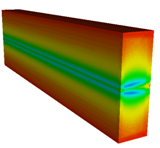Speaker
Alessandro BERTARELLI
(CERN)
Description
The collimation system which is being installed has been designed to ensure high robustness during
the LHC start-up and initial luminosity runs (Phase I). However, RF studies predict that the Phase I collimator
impedance will prevent the machine from attaining its nominal luminosity. Hence, from the early phases of
design, it has been envisaged to complement this system with a series of Secondary collimators (Phase II),
allowing to overcome the impedance issue and increase the collimation efficiency. One essential parameter
to meet such an ambitious goal will certainly be the type of material chosen for the new collimator jaws.
Given the Phase II collimation requirements, this “ideal” material shall have a low electrical resistivity and
a relatively high mass density. On top of this, a close-to-zero Coefficient of Thermal Expansion, high yield strength
and high thermal conductivity are desirable. The figures of merit which allow to identify the best candidate and
the rationale which is behind these figures will be illustrated.
Author
Alessandro BERTARELLI
(CERN)
